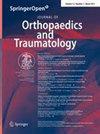肱骨近端骨肉瘤患者通过肢体抢救治疗后的功能和肿瘤预后
IF 3.7
2区 医学
Q1 ORTHOPEDICS
引用次数: 0
摘要
骨肉瘤是骨骼尚未发育成熟的患者最常见的原发性骨恶性肿瘤。肱骨近端是骨肉瘤的第三大常见部位。文献显示,有关肱骨近端骨肉瘤通过肢体抢救治疗的结果的公开数据很少。本研究旨在回答以下问题:(1)肱骨近端骨肉瘤患者通过肢体抢救和新辅助化疗是否能获得良好的功能和肿瘤学疗效;(2)是否存在与更好的肿瘤学和功能疗效相关的预后因素?该研究是一项回顾性病例系列研究,评估了34例肱骨近端骨肉瘤患者的总体预后。18名患者为男性(53%),16名患者为女性。15名患者(44%)进行了生物重建,19名患者进行了非生物重建。切除术主要在关节内进行(82%)。功能预后采用肌肉骨骼肿瘤协会(MSTS)评分进行评估,而肿瘤预后则根据局部复发和胸部转移情况进行评估。定量变量之间的比较采用非参数 Mann-Whitney 检验。比较分类数据时,采用卡方(χ2)检验。当预期频率小于 5 时,则采用精确检验。定量变量之间的相关性采用斯皮尔曼相关系数进行检验。平均 MSTS 得分为 25.5(范围为 23-29)。从统计学角度看,年龄越小,MSTS 评分越低(P = 0.0016)。34 名患者中有 6 名(17.6%)出现局部复发,其中 4 名(67%)接受了前肢截肢治疗。41%的患者出现胸部转移,其中大部分患者(71%)接受了化疗。与同样在本院接受治疗的其他部位骨肉瘤患者相比,肱骨近端骨肉瘤患者的局部复发率和胸部转移率较高,患者和肢体的5年存活率也较股骨远端、胫骨近端和股骨近端骨肉瘤患者低。肱骨近端骨肉瘤通过肢体抢救和化疗可获得良好的功能预后。重建方法并不影响最终的功能。这些患者的 5 年生存率为 65%。年轻患者的肿瘤预后较好,而功能预后较差。四级治疗研究。本文章由计算机程序翻译,如有差异,请以英文原文为准。
Functional and oncological outcomes of patients with proximal humerus osteosarcoma managed by limb salvage
Osteosarcoma is the most common primary bone malignancy in skeletally immature patients. The proximal humerus is the third most common site of osteosarcoma. The literature shows a paucity of published data concerning the outcome of proximal humerus osteosarcoma managed by limb salvage. The purpose of this study was to answer the following questions: (1) do patients with proximal humerus osteosarcoma managed by limb salvage and neoadjuvant chemotherapy show good functional and oncological outcomes, and (2) are there any prognostic factors that are associated with better oncological and functional outcomes? The study was a retrospective case series study assessing the overall outcome of 34 patients with proximal humerus osteosarcoma. Eighteen patients were males (53%) while 16 were females. Biological reconstruction was done in 15 patients (44%), while nonbiological reconstruction was done in 19 patients. Resections were mainly intraarticular (82%). Functional outcome was assessed using the Musculoskeletal Tumor Society (MSTS) score, while oncological outcome was assessed based on local recurrence and development of chest metastasis. Comparisons between quantitative variables were done using the nonparametric Mann–Whitney test. To compare categorical data, the chi-square (χ2) test was performed. The exact test was used instead when the expected frequency was less than 5. Correlations between quantitative variables were examined using the Spearman correlation coefficient. The mean MSTS score was 25.5 (range 23–29). A younger age was statistically correlated with a poorer MSTS score (P = 0.0016). Six patients out of 34 (17.6%) had local recurrence and four of them (67%) were treated by forequarter amputation. 41% of patients developed chest metastasis, and the majority of them were treated by chemotherapy (71%). In comparison with patients with osteosarcoma at other sites who were also managed in our institution, proximal humerus osteosarcoma patients showed higher incidence rates of local recurrence and chest metastasis along with lower 5-year patient and limb survivorships compared to distal femur, proximal tibia and proximal femur osteosarcoma patients. Treatment of osteosarcoma of the proximal humerus by limb salvage and chemotherapy yields a good functional outcome. The method of reconstruction does not impact the resultant function. The 5-year survivorship of these patients is 65%. Younger patients have a better oncological outcome and an inferior functional outcome. Level IV therapeutic study.
求助全文
通过发布文献求助,成功后即可免费获取论文全文。
去求助
来源期刊

Journal of Orthopaedics and Traumatology
Medicine-Orthopedics and Sports Medicine
CiteScore
4.30
自引率
0.00%
发文量
56
审稿时长
13 weeks
期刊介绍:
The Journal of Orthopaedics and Traumatology, the official open access peer-reviewed journal of the Italian Society of Orthopaedics and Traumatology, publishes original papers reporting basic or clinical research in the field of orthopaedic and traumatologic surgery, as well as systematic reviews, brief communications, case reports and letters to the Editor. Narrative instructional reviews and commentaries to original articles may be commissioned by Editors from eminent colleagues. The Journal of Orthopaedics and Traumatology aims to be an international forum for the communication and exchange of ideas concerning the various aspects of orthopaedics and musculoskeletal trauma.
 求助内容:
求助内容: 应助结果提醒方式:
应助结果提醒方式:


